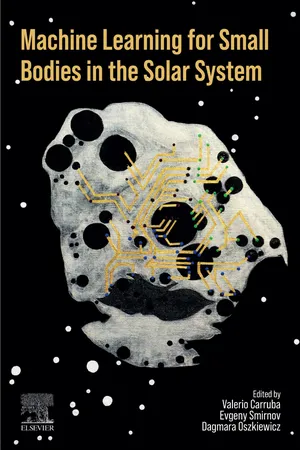
eBook - ePub
Machine Learning for Small Bodies in the Solar System
- 300 pages
- English
- ePUB (mobile friendly)
- Available on iOS & Android
eBook - ePub
Machine Learning for Small Bodies in the Solar System
About this book
Machine Learning for Small Bodies in the Solar System provides the latest developments and methods in applications of Machine Learning (ML) and Artificial Intelligence (AI) to different aspects of Solar System bodies, including dynamics, physical properties, and detection algorithms. Offering a practical approach, the book encompasses a wide range of topics, providing both readers with essential tools and insights for use in researching asteroids, comets, moons, and Trans-Neptunian objects. The inclusion of codes and links to publicly available repositories further facilitates hands-on learning, enabling readers to put their newfound knowledge into practice. Machine Learning for Small Bodies in the Solar System serves as an invaluable reference for researchers working in the broad fields of Solar System bodies; both seasoned researchers seeking to enhance their understanding of ML and AI in the context of Solar System exploration or those just stepping into the field looking for direction on methodologies and techniques to apply ML and AI in their work.
- Provides a practical reference to applications of machine learning and artificial intelligence to small bodies in the Solar System
- Approaches the topic from a multidisciplinary perspective, with chapters on dynamics, physical properties and software development
- Includes code and links to publicly available repositories to allow readers practice the methodology covered
Frequently asked questions
Yes, you can cancel anytime from the Subscription tab in your account settings on the Perlego website. Your subscription will stay active until the end of your current billing period. Learn how to cancel your subscription.
At the moment all of our mobile-responsive ePub books are available to download via the app. Most of our PDFs are also available to download and we're working on making the final remaining ones downloadable now. Learn more here.
Perlego offers two plans: Essential and Complete
- Essential is ideal for learners and professionals who enjoy exploring a wide range of subjects. Access the Essential Library with 800,000+ trusted titles and best-sellers across business, personal growth, and the humanities. Includes unlimited reading time and Standard Read Aloud voice.
- Complete: Perfect for advanced learners and researchers needing full, unrestricted access. Unlock 1.4M+ books across hundreds of subjects, including academic and specialized titles. The Complete Plan also includes advanced features like Premium Read Aloud and Research Assistant.
We are an online textbook subscription service, where you can get access to an entire online library for less than the price of a single book per month. With over 1 million books across 1000+ topics, we’ve got you covered! Learn more here.
Look out for the read-aloud symbol on your next book to see if you can listen to it. The read-aloud tool reads text aloud for you, highlighting the text as it is being read. You can pause it, speed it up and slow it down. Learn more here.
Yes! You can use the Perlego app on both iOS or Android devices to read anytime, anywhere — even offline. Perfect for commutes or when you’re on the go.
Please note we cannot support devices running on iOS 13 and Android 7 or earlier. Learn more about using the app.
Please note we cannot support devices running on iOS 13 and Android 7 or earlier. Learn more about using the app.
Yes, you can access Machine Learning for Small Bodies in the Solar System by Valerio Carruba,Evgeny Smirnov,Dagmara Oszkiewicz in PDF and/or ePUB format, as well as other popular books in Physical Sciences & Astronomy & Astrophysics. We have over one million books available in our catalogue for you to explore.
Information
Table of contents
- Machine Learning for Small Bodies in the Solar System
- Chapter One Artificial intelligence and machine learning methods in celestial mechanics
- Chapter Two Identification of asteroid families' members
- Chapter Three Asteroids in mean-motion resonances
- Chapter Four Asteroid families interacting with secular resonances
- Chapter Five Neural networks in celestial dynamics: capabilities, advantages, and challenges in orbital dynamics around asteroids
- Chapter Six Asteroid spectro-photometric characterization
- Chapter Seven Machine learning-assisted dynamical classification of trans-Neptunian objects
- Chapter Eight Identification and localization of cometary activity in Solar System objects with machine learning
- Chapter Nine Detecting moving objects with machine learning
- Chapter Ten Chaotic dynamics
- Chapter Eleven Conclusions and future developments
- Index